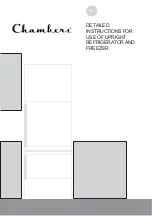
1.
THERMOSTAT DIAL: For controlling the temperature inside
the refrigerator/freezer. Turns the motor on as soon as the
temperature rises above the desired level.
2.
FREEZING COMPA RT M E N T WITH REVERSIBLE FREEZER DOOR:
Separate freezer section holds ice cube tray and frozen foods
3.
ICE CUBE TRAY: Ice cubes are easily removed from the tray.
(Not shown)
4.
PLASTIC COATED SHELVES: 3 full width shelves, 2 half
shelves are odor resistant, rustproof and removable for easy
c l e a n i n g.
5.
DRIP TRAY: Catches the water that drips off the evaporator
when defrosting.
6.
MAGNETIC GASKET: Tight fitting door seal keeps all the
cooling power locked inside. No hooks or latches.
7.
CRISPER WITH PLEXI-GLASS SHELF: Easy interior viewing.
8.
CANSTOR DOOR LINER: Holds 355 mL cans of pop,
juice, or beer.
9.
All Purpose Storage Container: for eggs, butter cheese etc.
can also be used to collect defrost water during defrost cycle.
Door Reversal Instructions
CAUTION: To avoid personal injury to yourself and/or
property, we recommend someone assist you during the door
reversal process.
1.
To access the lower hinge assembly, tilt back the refrigerator
cabinet or lay the refrigerator on its back.
(Fig. C)
2.
Remove both leveling legs located at the front of the cabinet.
3.
Remove the screws holding the lower hinge assembly to
the cabinet.
4.
Remove the main door assembly from the refrigerator cabinet.
(open door and pull down)
5.
Remove
(unscrew)
the main door top hinge pin.
(Fig. D)
6.
Re-install the main door top hinge pin on the opposite side of
the cabinet.
7.
Remove the door plug and door bushing located on the top of
the main door assembly.
8.
Interchange positions.
(ie. door plug right side, door bushing
left side.)
9.
Re-install main door assembly on cabinet.
10.
Remove door bushing
(bottom door)
and install on opposite side.
11.
Re-install the lower hinge assembly on the opposite side.
12.
Make sure the door assembly is properly aligned on the
cabinet, before tightening lower hinge screws.
13.
Re-install both leveling legs.
The process is now complete.
5
1
7
8
4
2
5
6
Fig. C
Fig. D


































